PHP is one of the most-used server-side programming languages, powering about 76% of active websites. Every year, we release our in-depth performance benchmarks for various PHP frameworks to see how different PHP versions stack up against each other.
In December 2023, we benchmarked PHP 8.1, 8.2, and 8.3 across 11 content management systems (CMSs) and frameworks: WordPress, WooCommerce, Drupal (versions 7 and 10), Joomla, Laravel, Symfony, CodeIgniter, Craft CMS, Typo3, Opencart, and Statamic. We also benchmarked WordPress and WooCommerce on PHP 7.4 since so many sites still run on this version.
As a best practice, we recommend always using the latest PHP version for optimized performance and security.
Our PHP Benchmarks
To evaluate how a CMS or framework performs against recent PHP versions, we ran benchmark tests. For consistency, we used the same machine and parameters for every tested CMS or framework.
The benchmark tests in this article were performed in the following environments:
- Machine: Intel Cascade Lake (30 core CPU) @ 3.10GHz, 120GB RAM, 1TB HDD. A Compute-Optimized (C2) virtual machine powered by Google Cloud Platform and running in an isolated container.
- OS: Ubuntu 20.04.6 LTS (Focal Fossa).
- CMSs and frameworks: Default setups, installed with DDEV v1.22.5
amd64onnginx-fpmas--webserver-typebased on the image version 1.22.0. - PHP versions: 7.4.33, 8.1.26, 8.2.13, 8.3.0
- Database:
ddev-dbserver-mariadb-10.4 - Tooling: ab – Apache HTTP server benchmarking tool.
- Concurrency: 15 requests at the same time.
- Requests: 1000 requests per session.
- Results: Obtained in requests per second (req/s). The higher the result, the faster the response.
CMSs and Frameworks
PHP is well known for its extensive library of frameworks and CMSs. We considered a few aspects in choosing which to test, including:
- Popularity
- Live websites
- Market position
- Usage trends
- Search volume (U.S.)
For example, WordPress keeps shining, representing 62% of the entire CMS market, with over 34 million live websites and a steep increase in usage over time.
On the other hand, while Statamic has a smaller footprint on the web, with some 10,000 live sites, its steep growth and increasing popularity have drawn our attention.
We also included Symfony. Although it’s been dropping in popularity over the past years compared to its previous spike, Symfony still has many active sites and a large monthly search volume.
The other CMSs and frameworks we chose to benchmark met the same standards.
Let’s take a look at the results.
WordPress
WordPress is an open-source CMS that makes it easy to manage important aspects of your website without knowing anything about programming. WordPress is beginner-friendly, and you don’t need to know how to code to install and maintain it, making it very attractive for anyone who’s not a programmer to start their website, blog, or web store.
WordPress is behind over 42% of all live websites. Looked at another way, that’s 62% of all well-known CMSs.
The open-source WordPress ecosystem is a boon to experienced programmers who want to build their applications based on a robust, flexible, and reliable platform.
WordPress is also widely used as a headless backend CMS for applications built with modern frontend frameworks like React, Vue.js, and others. You can use WordPress content management capabilities with static site generators like Gatsby, Hugo, VuePress, and Next.js.
And you can create a static version of your entire WordPress site to increase security and enhance performance. These contemporary approaches begin with a reliable platform for dynamic, stylish, and shiny web apps to stand out and attract visitors.
WordPress Benchmarks
- Tested version: WordPress 6.2.2.
- Tested URL:
/ - Size: 52,684,000 bytes.
- Results:
- PHP 7.4: 147 res/s.
- PHP 8.1: 151 req/s.
- PHP 8.2: 153 req/s.
- PHP 8.3: 165 req/s.
WordPress performs better with newer PHP versions. And the newer, the better. Upgrading to PHP 8.3 is a must for anyone concerned about the security and performance of their WordPress site.
To get the most out of WordPress, learn how to speed up your website. WordPress is well-known for its need for a good server to perform well. With Kinsta, you have the best hosting service, speed, and security and can easily manage your WordPress websites.
WooCommerce
WooCommerce is the most-used online selling platform. It helps merchants and developers build successful businesses for the long term. Holding nearly 20% of the ecommerce sites on the Internet, it is customizable, open-source, and built on WordPress. With WooCommerce, you have a safe, mature, and reliable infrastructure to sell online. Plus, you can leverage WordPress’s plugins, WP-CLI, hooks, filters, and REST API endpoints to manage your store.
WooCommerce Benchmarks
- Tested version: Woo 7.9.0 on WordPress 6.2.2.
- Tested URL:
/product/product/ - Size: 57,470,000 bytes.
- Results:
- PHP 7.4: 48 res/s.
- PHP 8.1: 49 req/s.
- PHP 8.2: 49 req/s.
- PHP 8.3: 58 req/s.
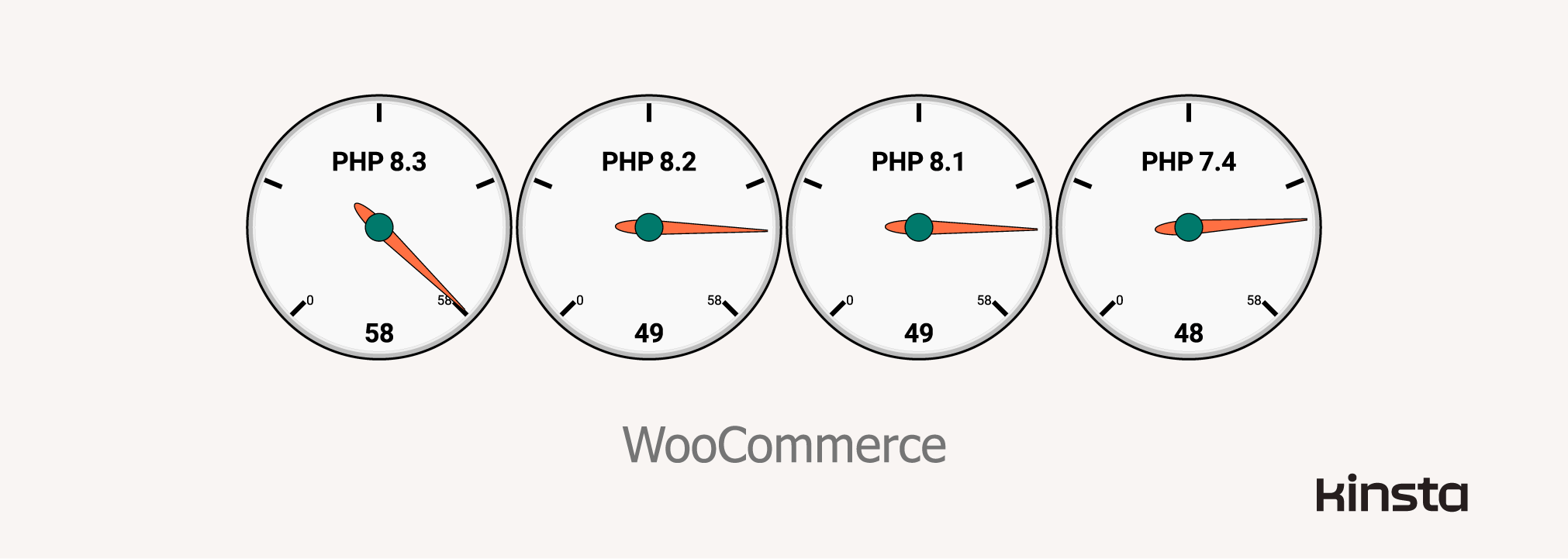
If your WooCommerce website runs on an older version of PHP, consider upgrading as soon as possible to gain a performance boost with PHP 8.3.
Laravel
Laravel is an open-source PHP framework that provides web developers with tools and resources for building modern PHP web applications. Built-in features, such as a command-line interface (Artisan), native authentication, and a model-view-controller (MVC) architecture pattern, make Laravel versatile and easy to use, contributing to its increasing popularity.
Laravel Benchmarks
- Tested version: Laravel 10.16.1.
- Tested URL:
/ - Size: 27,514,000 bytes.
- Results:
- PHP 8.1: 611 req/s.
- PHP 8.2: 670 req/s.
- PHP 8.3: 925 req/s.
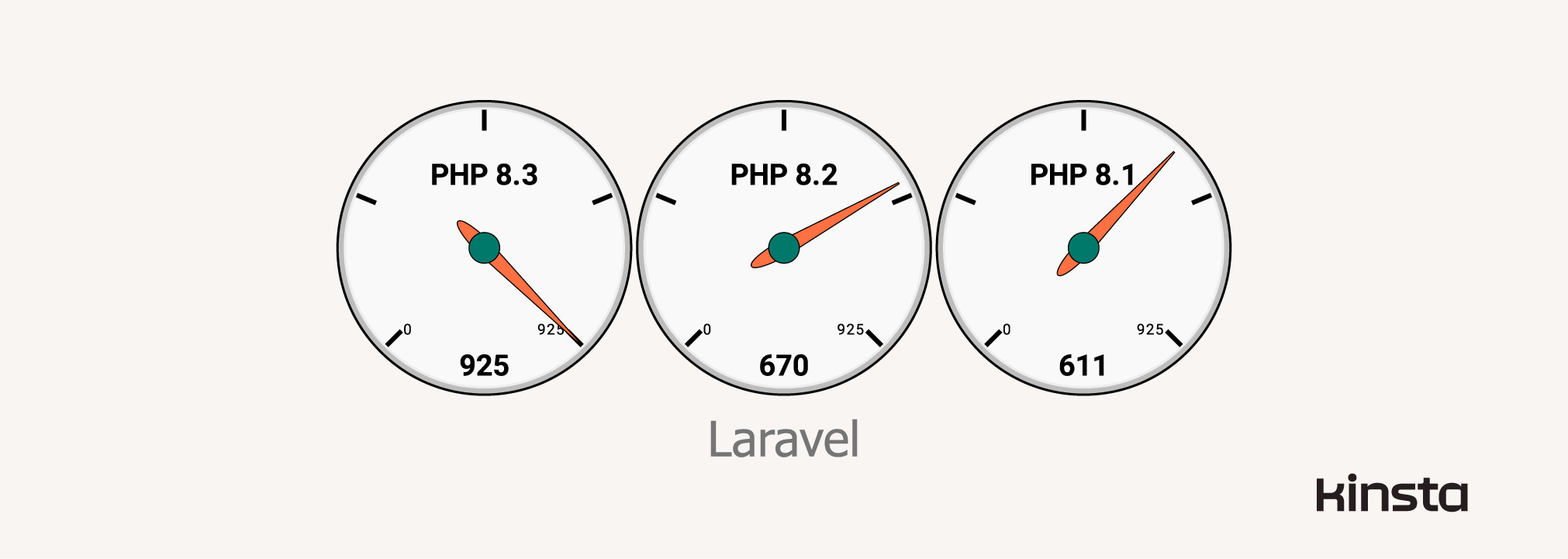
Laravel delivers a considerable performance increase when upgrading from PHP 8.1 to 8.2. With PHP 8.3, you gain another 38% over 8.2. Upgrading to 8.3 is a no-brainer.
Drupal
Drupal is a powerful and scalable CMS with great standard features, like easy content authoring, reliable performance, excellent security, flexibility, and modularity, which is one of its core principles. Its tools help you build the versatile, structured content that dynamic web experiences require.
It’s a great choice for creating integrated digital frameworks, as you can extend it with many add-ons. Drupal is more of a CMS development platform than an out-of-the-box website.
Drupal 7, released in 2011, persists as its most used version, so we benchmarked it along with Drupal 10, its latest and most-improved version.
Drupal 7 had its end-of-life scheduled for December 2023, but that was extended until January 2025 to give users more time to migrate.
Drupal Benchmarks
- Tested versions: Drupal 10.1.1 and 7.98.
- Tested URL:
/ - Size: 19,102,000 bytes (Drupal 10); 8,075,000 bytes (Drupal 7).
- Results (Drupal 10):
- PHP 8.1: 922 req/s.
- PHP 8.2: 941 req/s.
- PHP 8.3: 1432 req/s.
- Results (Drupal 7):
- PHP 8.1: 661 req/s.
- PHP 8.2: 753 req/s.
- PHP 8.3: 823 req/s.
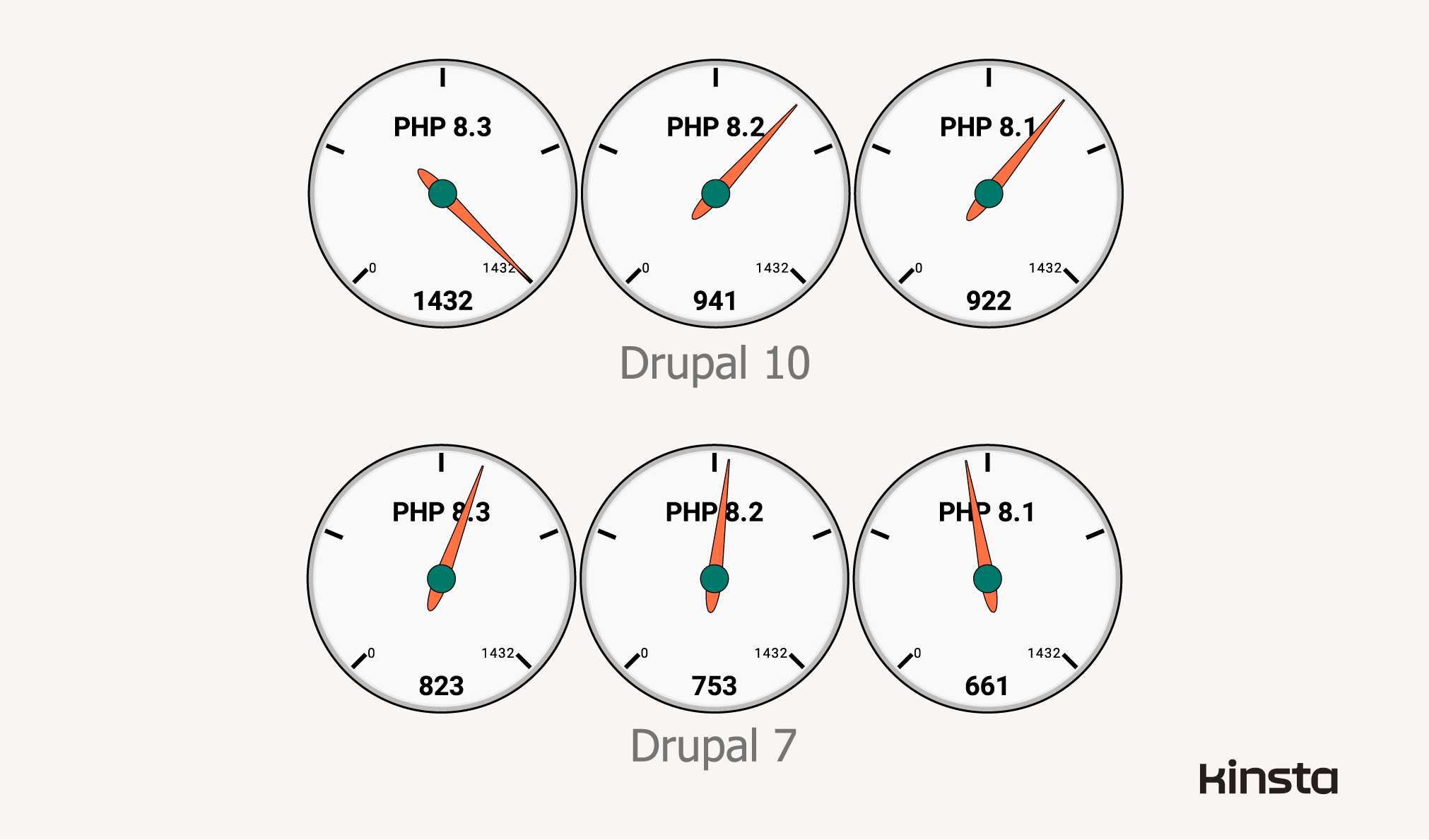
If you are still using an older Drupal version, consider updating it for performance and security reasons beyond leveraging all the new features and any upcoming improvements. Updates between Drupal 8, 9, and 10 are considered seamless for the majority of its community. It’s worth upgrading from 7 to 8 to prepare for Drupal 10 and get it up and running quickly.
From the benchmark results, it’s clear that upgrading from Drupal 7 to 10 significantly improves performance. Using PHP 8.3 with Drupal 10 gives you an extreme speed boost to satisfy your visitors and keep them engaged, making the upgrade the smartest move.
Joomla
Joomla is a popular open-source CMS built on a model–view–controller web application framework that can be used independently of the CMS to build online applications. It features a flexible system that is easy to extend and customize due to its large extension library. Joomla has built-in search optimization features and a great reputation for quickly releasing security patches before exploits spread.
Joomla Benchmarks
- Tested version: Joomla 4.3.3.
- Tested URL:
/ - Size: 8,111,000 bytes.
- Results:
- PHP 8.1: 274 req/s.
- PHP 8.2: 265 req/s.
- PHP 8.3: 341 req/s.
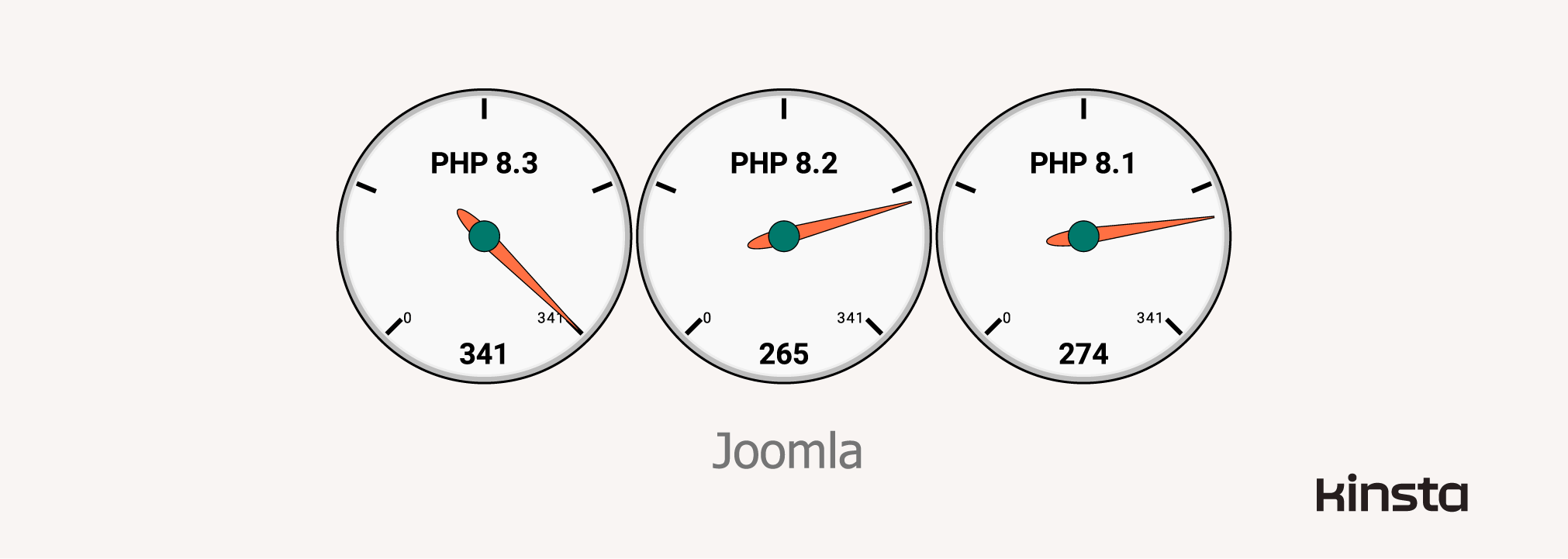
In our tests, PHP 8.1 and 8.2 benchmarks for Joomla didn’t vary significantly. On the other hand, with PHP 8.3, we saw an uplift of nearly 30%, making 8.3 the smartest choice for running your site.
Symfony
Symfony is a rich, flexible backend framework for complex applications. Its MVC architecture provides tools and features specifically designed for building systematic and scalable PHP web applications, including support for multiple environments and a robust caching system.
It’s popular among the open-source community and is well-supplied with a large library of components and bundles. For long-term business goals and vast audience-capturing websites, Symfony is a great choice.
Symfony Benchmarks
- Tested version: Symfony 6.3.0.
- Tested URL:
/ - Size: 559,000 bytes.
- Results:
- PHP 8.1: 931 req/s.
- PHP 8.2: 997 req/s.
- PHP 8.3: 1182 req/s.

Symfony is fast by nature. In our tests, PHP 8.1 and 8.2 performed similarly, but 8.3 shone above all of them.
CodeIgniter
CodeIgniter is a PHP framework built for developers who need a simple toolkit to create full-featured web applications. It takes the MVC approach to nurture simplicity. With a minimal footprint for a core system that requires only a few small libraries, its default landing page outperforms all platforms and frameworks we tested. You can start small and incredibly fast and build up as you need.
CodeIgniter Benchmarks
- Tested version: CodeIgniter 4.3.6.
- Tested URL:
/ - Size: 17,776,993 bytes.
- Results:
- PHP 8.1: 1120 req/s.
- PHP 8.2: 1180 req/s.
- PHP 8.3: 1684 req/s.
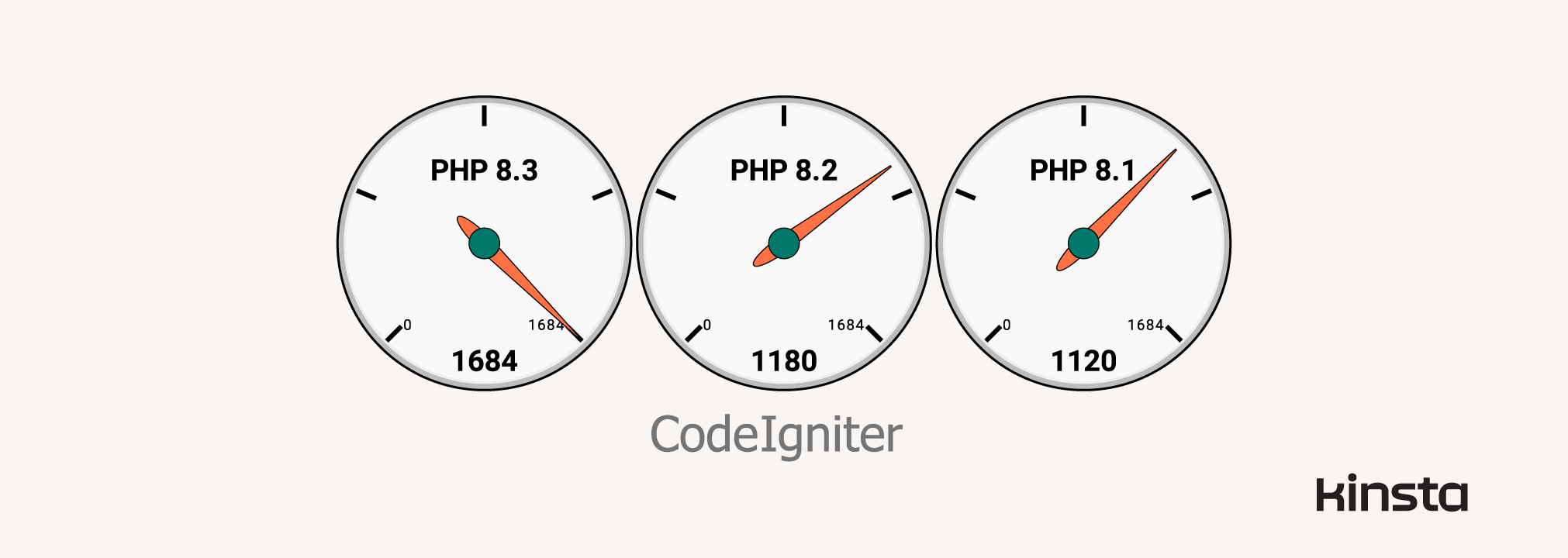
CodeIgniter, in its default installation, is fast — very fast. PHP benchmark results for 8.1 and 8.2 were similar, with 8.2 slightly quicker than 8.1. PHP 8.3 comes in full force with a 42% performance increase, making the upgrade another no-brainer.
Craft CMS
Craft CMS is an open-source platform designed for creating marketing and e-commerce websites. The Craft philosophy is to model the CMS around your content, not the opposite. With an intuitive user interface and a completely customizable backend, Craft leverages content creation so you can spend more time producing content and less time building your site.
Craft CMS Benchmarks
- Tested version: Craft 4.4.16.1.
- Tested URL:
/ - Size: 6,594,000 bytes.
- Results:
- PHP 8.1: 358 req/s.
- PHP 8.2: 354 req/s.
- PHP 8.3: 443 req/s.
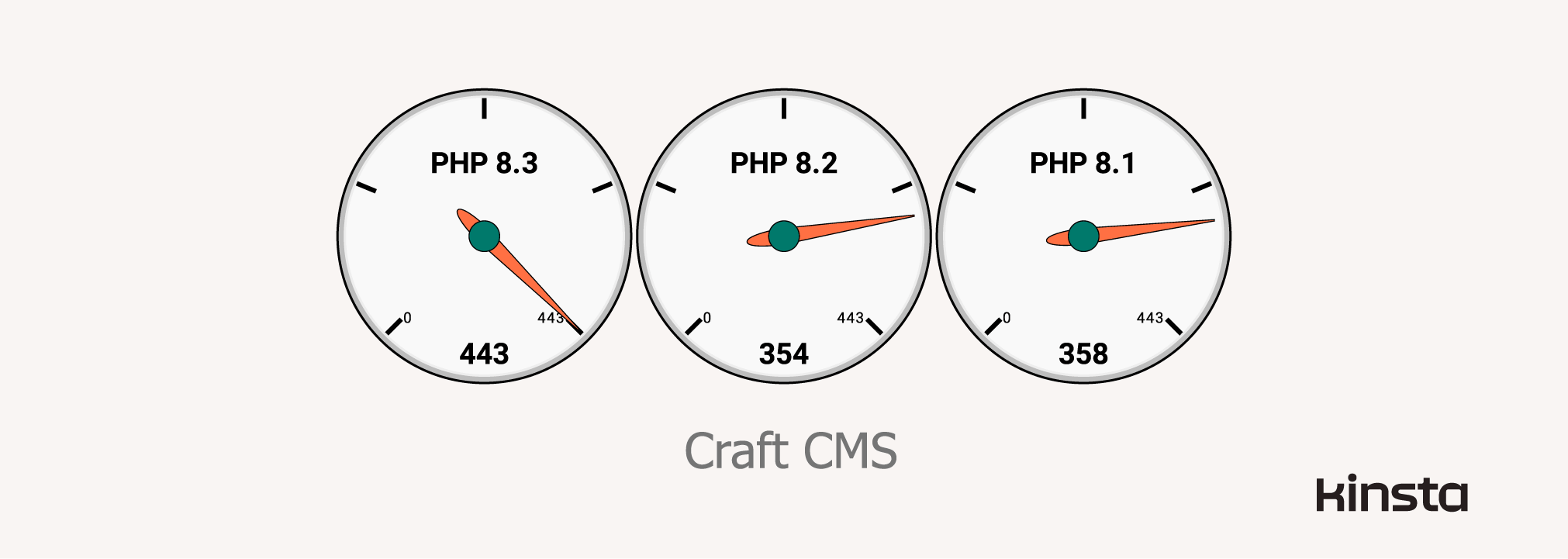
Running on PHP 8.1 and 8.2, Craft performs similarly, but PHP 8.3 comes in again to boost your site performance by about 25%.
OpenCart
OpenCart is an open-source e-commerce management platform that can handle one or multiple online stores from a single backend. With a user-friendly interface, OpenCart makes navigation easier for site administrators and end-users. The idea is that you can get an online store up and running with minimal effort and then customize it using available extensions.
OpenCart Benchmarks
- Tested version: OpenCart 4.0.2.2.
- Tested URL:
/ - Size: 33,014,000 bytes.
- Results:
- PHP 8.1: 151 req/s.
- PHP 8.2: 154 req/s.
- PHP 8.3: 164 req/s.

OpenCart runs smoothly on PHP 8.1, slightly faster on 8.2, and 8.3 gives it a considerable push, inviting you to upgrade.
Statamic
Statamic is an open-source CMS built on top of Laravel. It’s a highly flexible framework that can store its content, templates, assets, and settings in files instead of a database, making version control a breeze. It adapts to your needs, allowing you to build up as you go. You can connect it to a database if that’s where your content is. You can export to a static site and simply do away with Laravel and PHP on the frontend.
Statamic Benchmarks
- Tested version: Statamic 4.13.2.
- Tested URL:
/ - Size: 7,233,000 bytes.
- Results:
- PHP 8.1: 58 req/s.
- PHP 8.2: 64 req/s.
- PHP 8.3: 72 req/s.
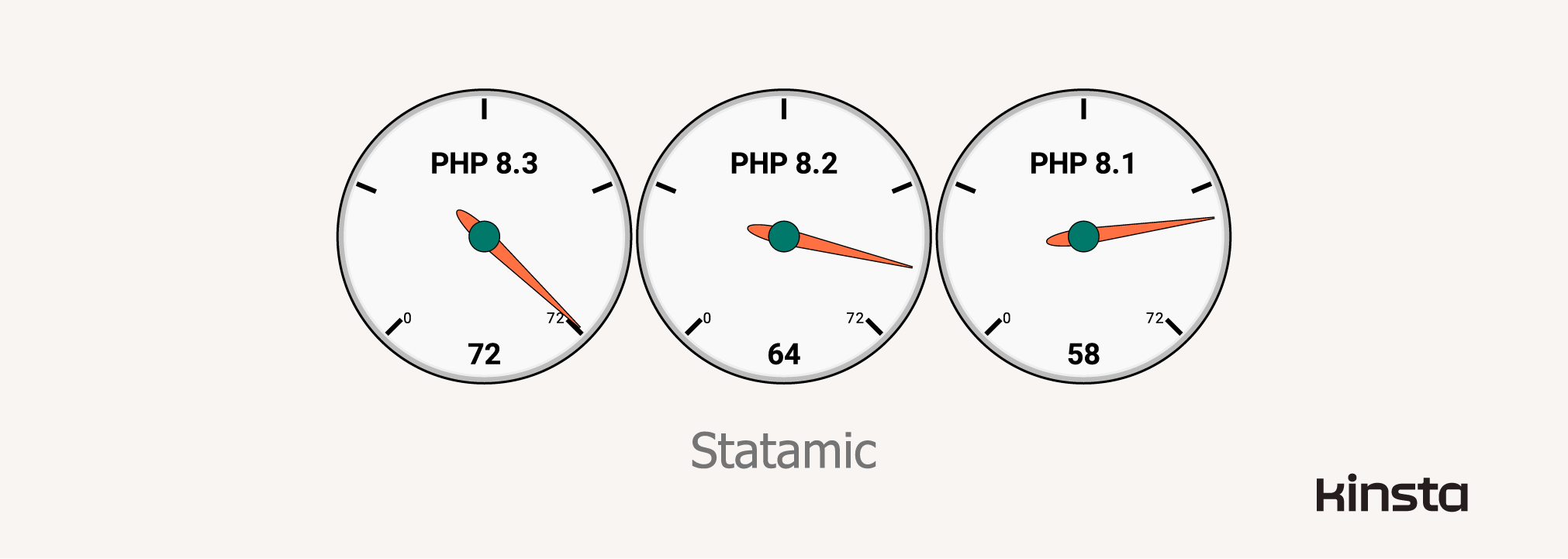
Statamic’s performance increases with each PHP minor version upgrade. With PHP 8.2, you gain about 10% in speed over 8.1. Upgrading to 8.3 gives you a boost of about 12%.
Typo3
Typo3 is an open-source CMS built in a multi-layered system that provides an API to access information recorded in a database, such as content, user permissions and access, content editing, and file management. Typo3 can be extended with plugins, backend modules, skins, and third-party apps. It’s a robust and reliable system that can support even large sites.
Typo3 Benchmarks
- Tested version: Typo3 12.4.4.
- Tested URL:
/ - Size: 2,085,000 bytes.
- Results:
- PHP 8.1: 509 req/s.
- PHP 8.2: 461 req/s.
- PHP 8.3: 598 req/s.
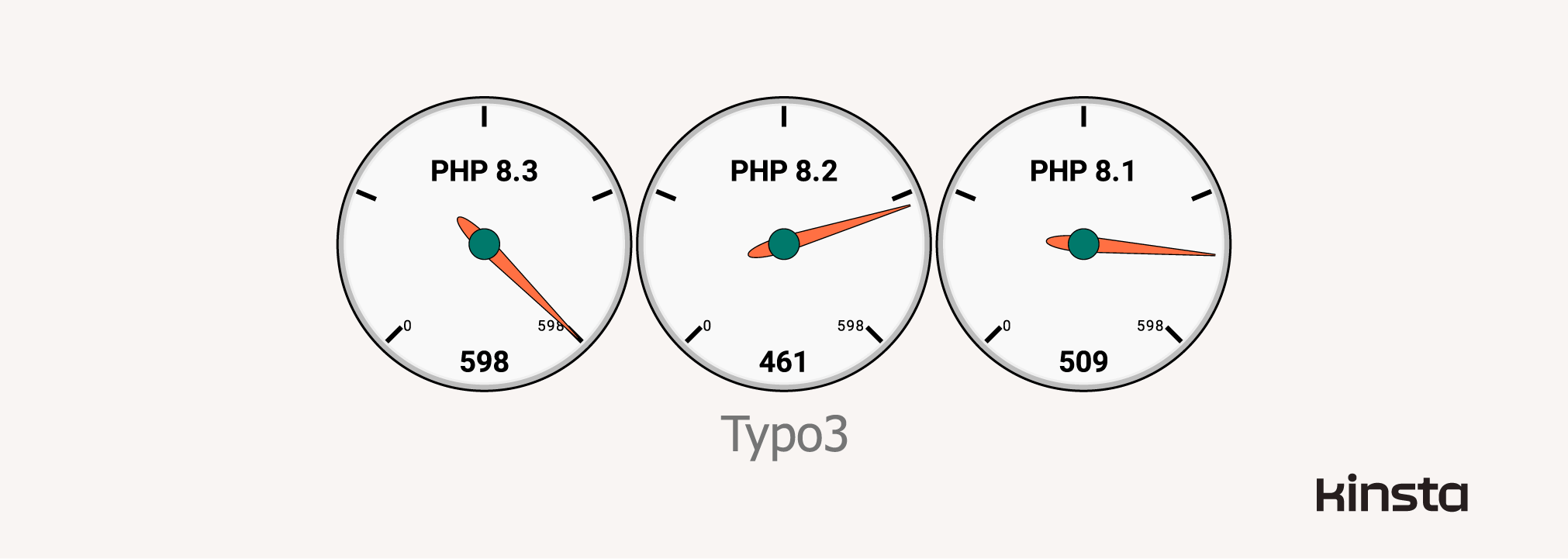
Typo3 performed slightly better with PHP 8.1 than with 8.2 in our tests, which was surprising. But upgrading to 8.3 is your best bet, considering outstanding performance and increased security.
The PHP Story
Created in 1994 by Rasmus Lerdorf and released to the public in 1995, PHP gained popularity for its ability to communicate with databases. Since then, PHP has gradually adopted object-oriented programming patterns, evolving into a mature, flexible, and robust modular language focused on reusability and maintainability.
PHP’s extensive ecosystem of libraries and frameworks has contributed to its popularity and ease of development. The result is enhanced security and additional functionality, making PHP a reliable choice for building intelligent, dynamic, and complex web applications.
PHP 7, released in December 2015, introduced significant performance improvements, resulting in the fastest and most efficient PHP major version until then. On top of that, PHP 8.0, 8.1, and 8.2 brought many new features and optimizations, as well as further improvements to consistency and performance.
PHP 8.3, released in November of 2023, introduced new functions, improvements to readonly classes, additions to the recently added Randomizer class, stack overflow detection, increased performance, and much more.
PHP Usage Statistics
PHP remains the predominant programming language for web applications. It’s behind more than 76% of sites that use server-side scripting:

If we look at the market positions among server-side programming languages, we see that JavaScript is popular among developers of high-traffic applications, while PHP appears on a greater number of sites.
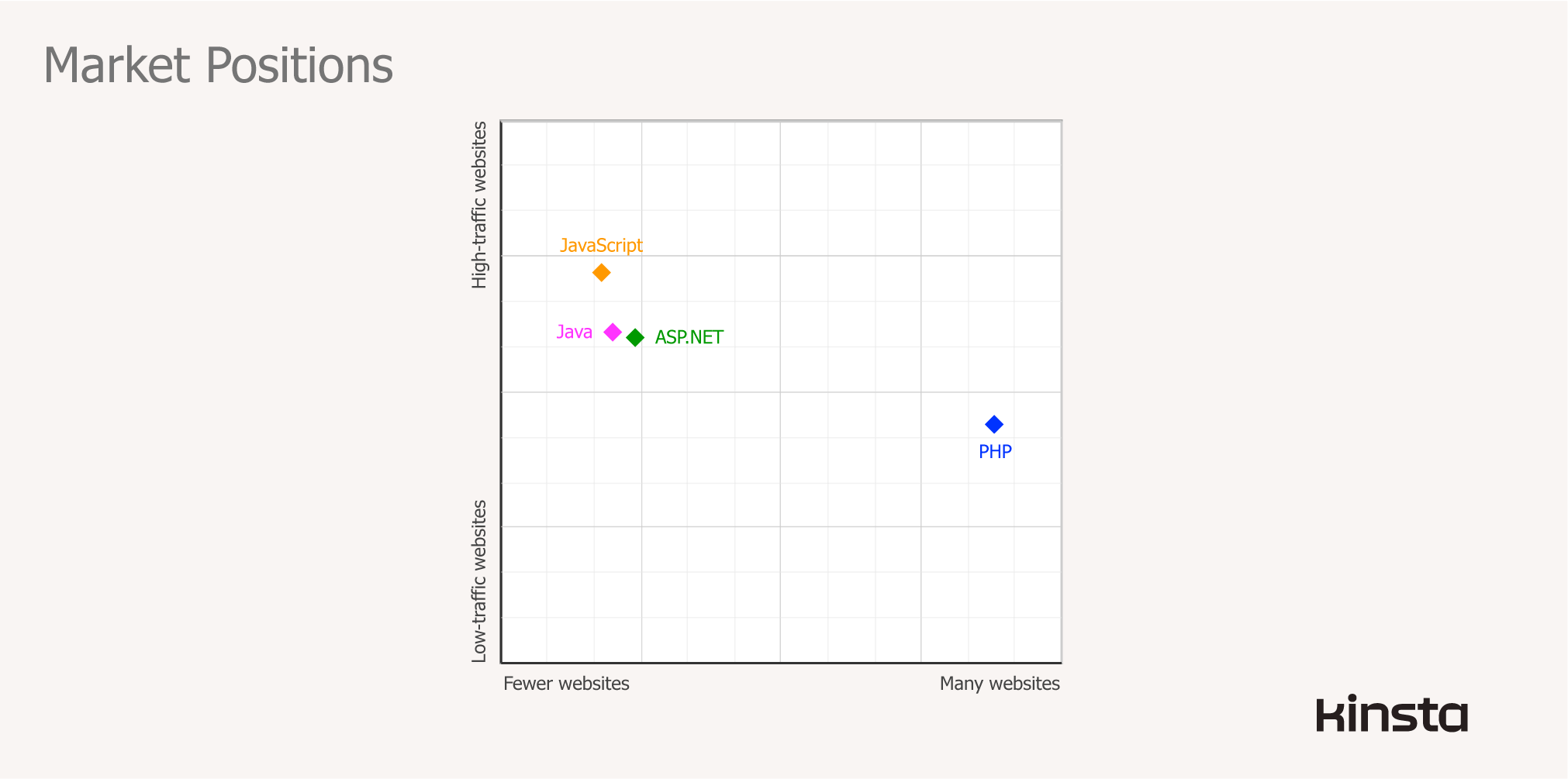
Many robust and high-traffic websites use PHP, including:
- Facebook.com
- Microsoft.com
- Wikipedia.org
- WordPress.org
- Vimeo.com
- MSN.com
- WordPress.com
- Mozilla.org
For its robust construction, consistency, maintenance, and flexibility, PHP has sustained its leadership position over the years:

Although PHP’s developers regularly push updates and improvements, users are sometimes apprehensive about upgrading to the latest version. That can be a mistake. The latest stable version of any application is the richest and safest to use.
When PHP 8.0 was released, many in the community were uneasy about upgrading, fearing incompatibilities with its previous sibling, 7.4. In addition, many web-hosting providers simply haven’t made the effort to get their customers on board with newer releases.
PHP 7.4 remains the most-adopted subversion, found behind 40% of PHP-powered sites.
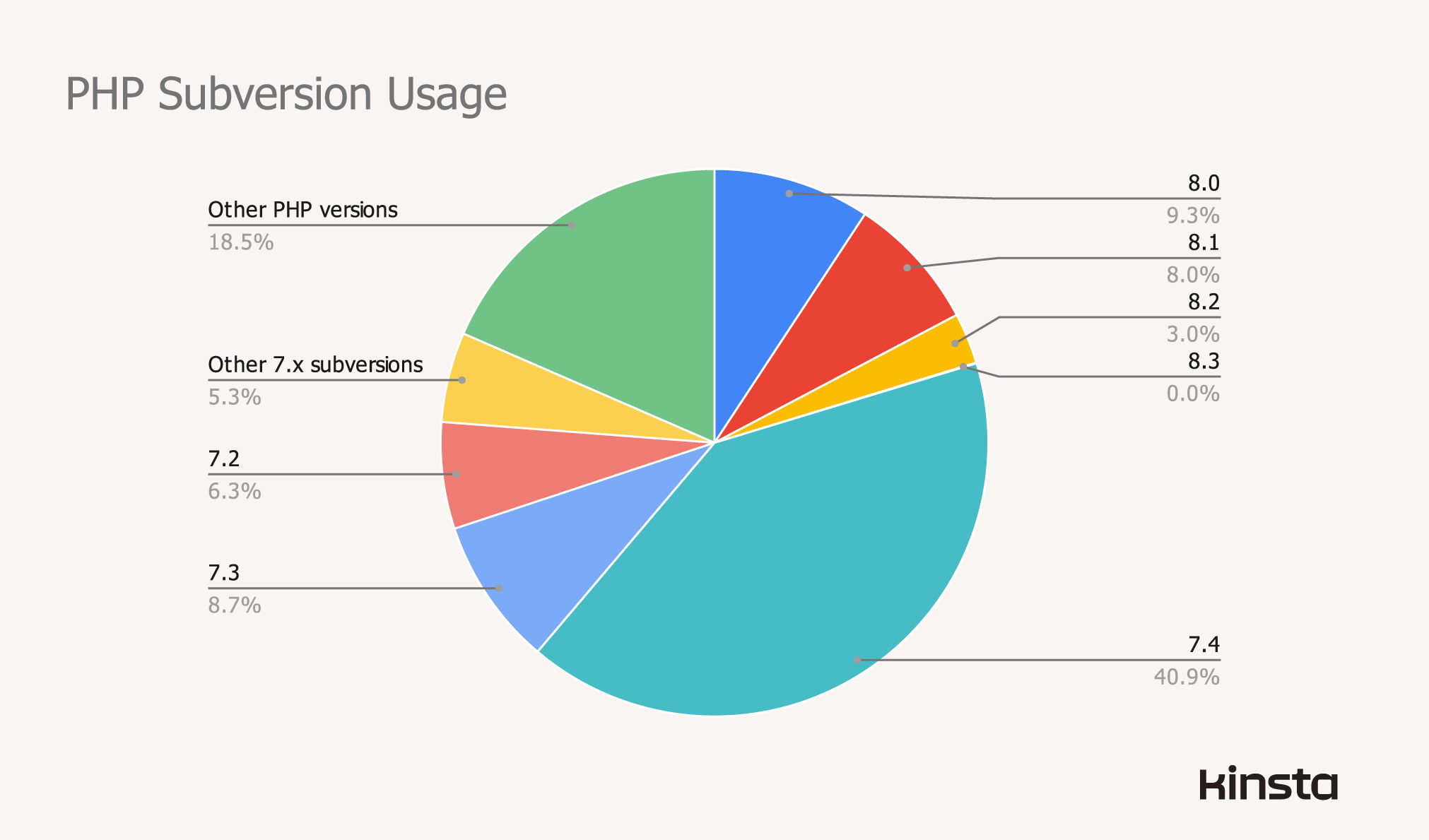
If you are using an older PHP release, consider upgrading progressively, from minor-to-minor versions, and making the necessary adjustments in between. This process is less prone to errors. For instance, don’t try to upgrade from 7.4 directly to 8.3. Upgrade to 8.0 first, and make your adjustments and tests. Then, upgrade to 8.1, adjust, and test. Then, upgrade to 8.2 and, finally, to 8.3.
Summary
In a nutshell, most of the CMSs and frameworks tested perform better with newer PHP versions. Whenever possible, opt to run your app in the latest versions of the tech stack you use.
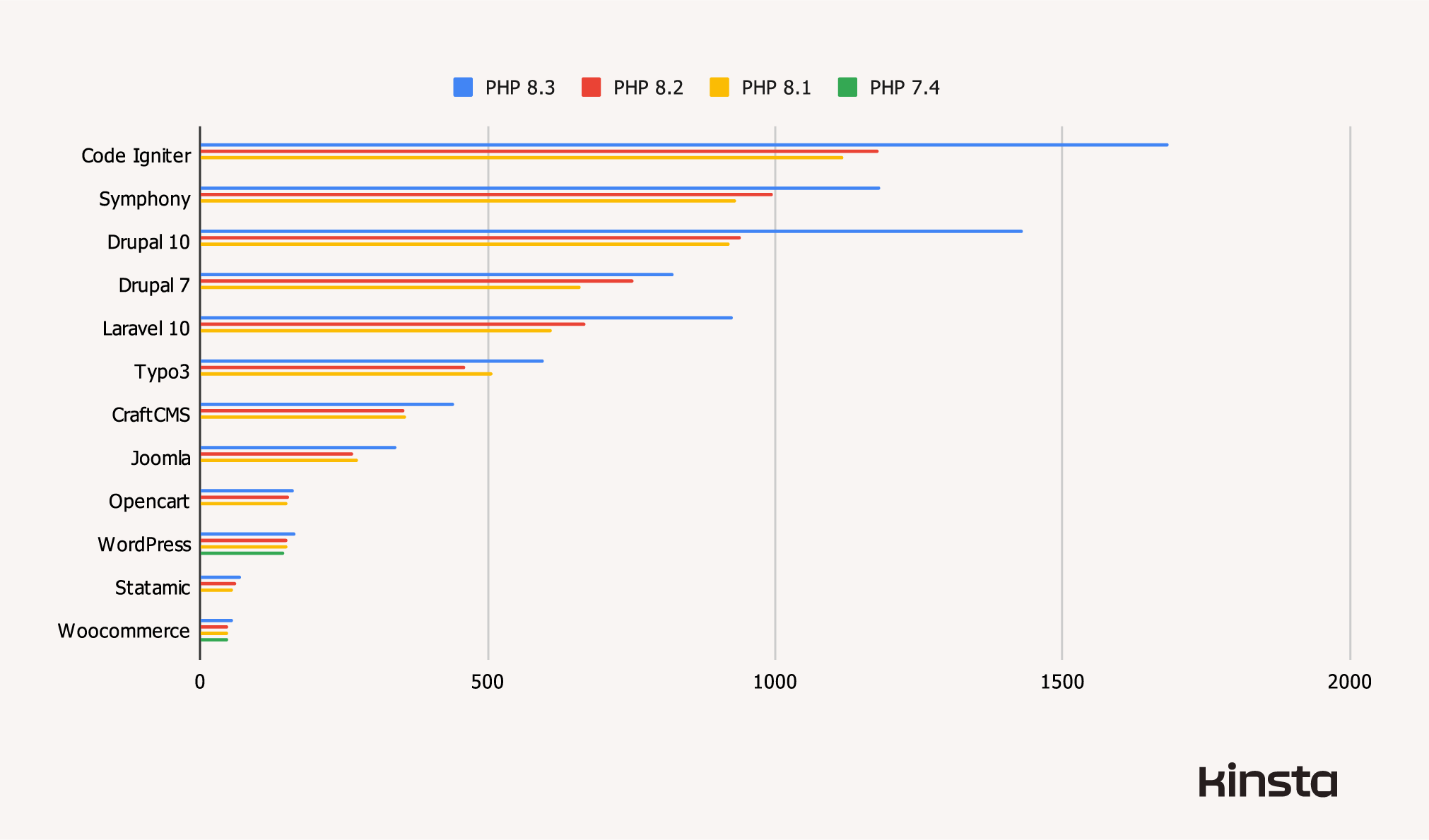
PHP 8.3 delivers outstanding results. Besides the new features and updates, 8.3 was proven the fastest tested version in our tests, providing up to 52.20% performance boost to the tested CMSs and frameworks.
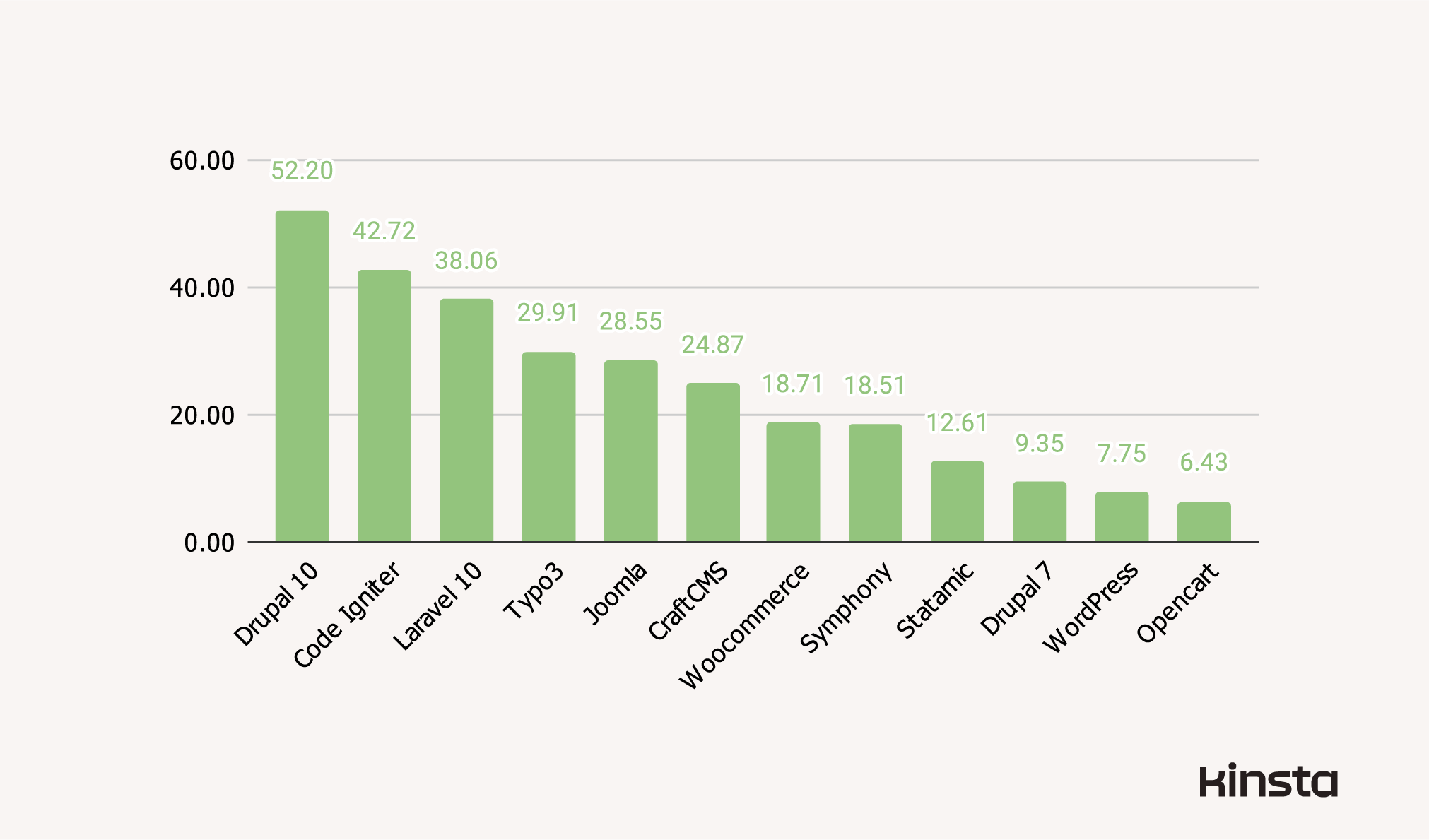
Learn how to migrate from PHP 8.2 to 8.3 in the official migration guide.
When it comes to website and application performance, everything starts with good hosting. It doesn’t matter if you invest heavily in application optimizations if your server is your bottleneck.
It’s not worth paying for cheap hosting if it cannot handle big traffic spikes when you need it the most. It’s not worth having a beautiful website if it’s frequently unavailable.
With Kinsta, you can host and manage all your projects on one reliable and scalable platform:
- WordPress and WooCommerce: Kinsta offers word-class Managed WordPress Hosting. All plans include a staging environment, redirects, automatic backups, SSL, PHP versions switch, WP-CLI, SSH, Git, performance monitoring tool, ionCube loader, and one-click cloning. Enjoy scalable server resources, rock-solid security, and 24/7 support.
- Applications and Databases: Deploy directly from your GitHub, Bitbucket, or GitLab repos without external development tools. Store data on persistent storage or internally connected databases with no row count limits, query limits, or paying for internal traffic. Access your app via Web Terminal. Run unlimited Cron jobs. All are powered by Kubernetes with optional automatic horizontal scaling.
- Static Sites: Create a static or Jamstack site yourself or use a static site generator. Let us run the build process and deploy directly to the edge. This is global speed and security at its best. And it is 100% free at Kinsta.
Kinsta deploys your projects on infrastructure built on Google Cloud Platform’s Premium Tier Network and fastest machines. We are SOC 2 compliant. We take your security seriously with isolated container technology, two strong firewalls, and advanced Cloudflare DDoS protection. What’s more, you can integrate apps or automate workflows with the Kinsta API.
What are you waiting for? Join us now!

